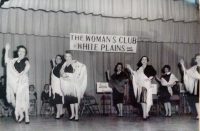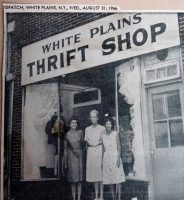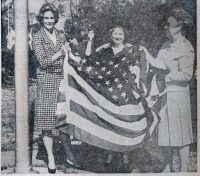Celebrating the 100-Year History of the Woman’s Club of White Plains, The 1960’s

By Colleen Fay – The Sixties was a decade of change. It was a decade of civil unrest and a decade of peace, love and harmony. It was the decade of the Beatles and Woodstock, the mini-skirt, tie dye, leather and beads, LSD and mind expansion, the “Pill,” the first man on the moon, civil rights legislation, Kent State and the war on poverty.
What was the Woman’s Club up to at this time? There was definitely Flower Power going on, just not the hippies’ kind. The Garden Committee was a very active and productive part of the club and the section was a member of the Federation of Garden Clubs. They sponsored annual flower shows with various themes including Our Country’s Flag and It’s a Man’s World. The May 1964 Flower Show had a Mayan theme. Birdcages filled with tropical plants and birds were placed on pedestals at the auditorium entrance and local scout troops prepared two exhibits on water conservation. Many other club events had floral overtones such as the Tulip Bridge. The Garden Committee was also responsible for the flowers at club functions as well as overseeing the grounds and gardens of the house.

There was also the Woman’s Club version of Woodstock. It was not the Beatles or the Rolling Stones, but there were musical gatherings of sell-out crowds. Musical revues written and performed by Club members and some adventurous husbands were quite popular and became annual events. As many as 80 club members and husbands volunteered to perform in these shows. The performances were usually fundraisers and had a number of themes including “Suburbia” and “Wing Ding.” Suburbia raised $5,700 for St. Agnes Hospital. For the 50th anniversary celebration, a revue entitled “Every Wednesday” was produced, highlighting events and activities of the Woman’s Club from the first 50 years. Of course, traditional musical programs continued to be popular. The genres, however, tended to be classical music, opera, piano or violin, not rock and roll.
Despite the upheaval in society in general, the Woman’s Club remained true to its charitable, philanthropic, civic and educational purposes. A Re-evaluation Committee was formed with the task of evaluating and recommending changes in how the Club accomplished its mission. Membership was still strong, about 500 active members at the start of the decade, which declined slightly by 1969.

Ever committed to keeping its members abreast of political and social issues, the Civic Department was one of the most prominent and active sections and it took great pains to bring in speakers on numerous current issues. These programs were open to the general public. At least two lectures were devoted to the war in Vietnam, one in 1967 and the other in 1969. Both lecturers were confident that victory was at hand. Both, unfortunately, were wrong. Other topics included the court system in New York State, Medicare and Medicaid, drug addiction and parental responsibility, fiscal awareness for women, international affairs and a talk entitled “Who’s Watching You?” on privacy and individual liberties, a discussion that continues to this day.
Another responsibility of the Civic Department was being involved in community affairs and a member of the Woman’s Club was sometimes invited to sit on city-sponsored committees.
The Club continued to sponsor the annual welcome breakfast for new teachers and the annual Mayor’s Luncheon. The practice of hosting a community forum for local candidates began in the 60’s. Common themes in these forums were the environment, nuclear energy, tax relief and an end to the war. It is worth mentioning that much of what was at the forefront of the political and social arena in the 60’s is the same today.
The Urban Renewal Project was a big topic of conversation at this time as downtown White Plains was undergoing a massive facelift and renovation. There were multiple presentations at the Club by city officials describing the project and its impact on the future of White Plains. One casualty of the project was the Farley building, site of the beloved Button Factory where the Club first met. Today it is Pizzeria Uno and Orawapaum Street now ends at Fisher Avenue, not Main Street.
Philanthropy was foremost on the Club’s agenda and the Club was often lauded in the newspapers for its contributions to local organizations especially the Community Chest (now known as the United Way), YWCA, YMCA, Girl Scouts and the local hospitals.
The Evening section was still primarily responsible for raising money for scholarships each year but the Thrift Shop was the biggest contributor to the Philanthropy war chest. Its motto was “Philanthropy is Everybody’s Business.” In the early 60’s, the Thrift Shop was having some difficulties as a number of discount and bargain stores had opened in the area and competed with it for customers. In addition, donations had dropped off. For a number of years, the Shop was actually in the red and at one point, the club considered divesting themselves of the Thrift Shop as some thought it was becoming obsolete. The Thrift Shop had another hurdle to overcome when it too became a victim of the ongoing urban renewal project. Almost since its beginning, the Thrift Shop was located in a barn behind the Reporter Dispatch building on Church Street but this area was slated for redevelopment. In June 1966, the Thrift Shop closed its doors but its demise was short-lived. A better location was found on Grove Street and the shop re-opened in August 1966. Members of the club painted, laid new carpets and cheerfully decorated their new digs. The community breathed a sigh of relief that the Thrift Shop was back in business so quickly. The new location was better for sales and eventually the Shop was operating in the black once again.
Several new events were started during the 60’s. A Thursday morning bowling league was formed by the Philanthropy Committee and was quite popular. “Treasures and Trivia,” a tag sale and silent auction was first held in 1964 and became an annual event. Admission was 50 cents. A “Come As You Are” Luncheon Bridge was held on the patio one summer. The First Thanksgiving Gala was held in 1967. It was very successful and it was hoped that a November gala would become an annual event. Free babysitting for Club Day was instituted in 1969.
There were also improvements in the house. A new fifty-star flag was donated by Odgen Reid, congressman from the 26th district. On October 16 1963, Mrs. Reid presented the flag to the Club on behalf of her husband. The flag, which had previously flown over the Capitol building in DC, was raised in a ceremony attended by Club officials and Mrs. Reid. In 1961, the murals in the dining room were authenticated by Robert Samuels and felt to be work of Claude Jules Vernet (1714-89). The murals were restored and remounted the same year. A new sound system was installed in the auditorium.
Club Dial continued to be a successful literary magazine. The Dial Shopper and monthly book reviews were staples of each issue. Towards the mid-60’s, ads began appearing in the Dial for various club events.
Helen Oleson became president in 1968. She was the first daughter of a club member to attain this position. One of the goals of her presidency was for members to get to know each other better. For several years, Club Dial had been running a section entitled “Getting to Know You” but Mrs. Oleson wanted to expand on this. She introduced the use of name tags at Club Day which were color coded depending on what section or board position one held. She even made the radical recommendation that the first name of each member be published in the yearbook. It was common practice in society for a married woman to be known by her husband’s name in public so this was quite a change. She also reiterated the Club’s charter for “the promotion of charitable, civic, educational and philanthropic purposes” and hoped to foster more general participation in the club.
The highlight of the decade, of course, was the Golden Anniversary of the Club and like today, there were many events to commemorate it.
As the 60’s ended, Neil Armstrong had just walked on the moon, the original internet, named Arpanet, was invented and, most significantly for the Club, the Women’s Lib movement was picking up steam. Women were no longer content to be homemakers and stay at home moms. How would the Woman’s Club of White Plains respond to the new roles and expectations of women in society in the coming decade? Stay tuned for the 70’s.

Examiner Media – Keeping you informed with professionally-reported local news, features, and sports coverage.
